Ageed Mike, "patients are the widgets that must be processed" additionally when it costs close to $3,700 a month for…
News 4/10/13
The HHS inspector general and CMS propose rules that would update and extend existing safe harbor exceptions and allow hospitals to continue subsidizing EMRs for affiliated physicians.
Reader Comments
From Wildcat Well: “Re: HIE. ONC announces an interest in a nationwide interoperable HIE. Is this not the same initiative as the CommonWell Health Alliance pilot? CommonWell will be a 501(C)(6), but regardless. Looks like a race of private vs. the government. Thoughts?”
From Shodan the Barbarian MD: "Re: Shodan search engine. Guess you could easily find the IP address of a monitor, anesthesia machine, ventilator, or IV pump and change the settings. Scary with the virtually non-existent security of these devices.” A CNN article covers the Shodan search engine, a Google-like service that finds any device connected to the Internet such printers, webcams, routers, servers, security cameras, and even medical equipment. Many of those devices have no security protection at all, and many more have the manufacturer’s original password or an easily guessed replacement like “password1” or “1234”. An independent security consultant was able to run a car wash, turn off the cooling system of a hockey rink in Denmark, and access the control system of a French hydroelectric plant.
From Bob Loblow: “Re: QuadraMed. CMIO Joe Bormel, MD has left after 10 years and is now with ONC.” His LinkedIn profile still shows him as an independent consultant, having left QuadraMed in January 2013. Update: readers confirmed that Joe started as ONC’s medical officer on Monday, April 8.
From JM: “Re: healthcare IT resources. What would you recommend a recent graduate do to better understand the HIT environment? Are there specific resources, entry-level positions, or education to seek out?” This question comes up every few months and I always invite readers to provide advice.
From Marie: “Re: at-risk contracts. I am doing research for a master’s program. We hear about at-risk contracts between payers and providers, but why haven’t we seen a similar movement between HIT vendors and providers? Why aren’t providers demanding that vendors go at risk for the cost and quality results they promise? Why aren’t vendors offering it to create competitive advantage?” I can only say that you’d be crazy as a vendor to make a hospital your partner knowing they don’t have the focus and capability to deliver the 80 percent of an HIT project’s value that comes from how a system is used rather than the system itself. That would be like a hammer manufacturer going at risk that you’ll build something nice with their product and pay them if so. I’ve had experience writing at-risk contracts as a customer and either party could get royally screwed just because some idealistic metric (readmissions, medication errors, cost per case, etc.) went up or down over several years because of factors entirely unrelated to the new system. Perhaps you could look at more specific measures such as orders originating from an order set, accepted clinical warnings, or decreased turnaround time, but it’s hard to assign a dollar value to those. But I’ll let readers chime in and help Marie with her project.
HIStalk Announcements and Requests
![]() This week marks my sixth anniversary at HIStalk. Happily I still think it’s the best job in HIT. In fact, every once in awhile I have to pinch myself to make sure I am not dreaming and that I am not about to wake up in the middle of the night to catch a 6:00 a.m. flight for an EHR demo to a bunch of doctors and their transcriptionists(!) Thanks Mr. H for keeping it fun.
This week marks my sixth anniversary at HIStalk. Happily I still think it’s the best job in HIT. In fact, every once in awhile I have to pinch myself to make sure I am not dreaming and that I am not about to wake up in the middle of the night to catch a 6:00 a.m. flight for an EHR demo to a bunch of doctors and their transcriptionists(!) Thanks Mr. H for keeping it fun.
Welcome to new HIStalk Platinum Sponsor Xerox, and specifically its Healthcare Solutions business. The company’s provider offerings include system selection and implementation (Meaningful Use, EHR, ERP, revenue cycle, ICD-10), optimization (technology and infrastructure, extended business office, collections, compliance), and analytics (clinical surveillance, decision support, care management, case management, and benchmarking). The company has been serving providers for 25 years, has 1,500 hospital clients, works in 31 states, and does work for 19 of the top 20 health plans. Some of the major vendors supported are Epic, Cerner, GEHC, Siemens, Meditech, McKesson, Allscripts, Infor Lawson, and Kronos. Thanks to Xerox for supporting HIStalk.
Here’s a video I found on YouTube that provides an overview of Xerox in healthcare.
Acquisitions, Funding, Business, and Stock
A Wisconsin newspaper’s article called “Life After Epic: From Epic ‘Grad’ to Entrepreneur” covers companies started by still-young former Epic employees, some of them working from a railroad car converted to co-working space. A local entrepreneur networking group estimates that 50 former Epic employees are working startups in the Madison area, most of them not healthcare related. A new entrepreneur says Epic’s one-year non-compete clause provides a good time to start a company.
Allscripts CEO Paul Black was paid $9 million in his first 12 days on the job, according to the Chicago business paper. Most of that was in stock and bonuses. Glen Tullman, his fired predecessor, made $7.1 million in 2012.
iMDsoft opens a new office in Dusseldorf, Germany that will provide around-the-clock support to its customers in Germany, Austria, and Switzerland.
Sales
Presence Health (IL) will deploy the Medseek Predict CRM solution.
Mississippi Medicaid selects the MedeAnalytics Accountable Care Solution to warehouse claims and clinical data collected from various HIEs.
The Ocean Beach Hospital (WA) board of commissions approves the purchase of Healthland’s EHR.
Planned Systems International and its partner Mediware win a $5 million DoD contract to provide validation services for the Enterprise Blood Management System.
People
Versus promotes Kevin Jackson to VP of technology.
Terry McGeeney, MD (TransforMED) joins healthcare consulting firm BDC Advisors.
MedeAnalytics hires Ping Zhang (Epocrates) SVP of product innovation and CTO.
Paula Sanders is promoted to chair of Post & Schell’s national Health Care Practice Group of 30 attorneys, representing clients on health facility regulation including RAC audits, HIPAA, and fraud and abuse.
Announcements and Implementations
The Joint Commission issues a Sentinel Event Alert after 80 deaths between 2009-2012 are found to be related to medical device alarm fatigue.
Massachusetts General Hospital and American Well announce a telehealth pilot program that will initially focus on child and adolescent psychiatry, heart failure, and neurology.
Christus Health Systems and Legacy Community become the first providers in Houston to share patient data via the Medicity-powered Greater Houston Healthconnect HIE.
Western Maryland Health System implements the Visibility Staff Assist solution from Versus Technology.
The local paper profiles St. Luke’s Regional Medical Center (IA) and its recent transition to EHR. The paper notes that, “The Affordable Care Act, commonly called Obamacare, requires health care providers to move to electronic medical records by 2014” and that, “Epic is not interoperable with hospitals and clinics that use other forms of electronic medical record.”
CIC Advisory announces a Meaningful Use Stage 2 benchmarking tool that includes on-site interviews and reviews followed by a detailed scorecard for a flat fee of $2,500.
Technology recruiter Greythorn offers its first Healthcare IT Market Report. It covers salaries, benefits, consulting , bonuses, and part-time employment.
Spain’s first telemedicine service launches as La Palma and Tenerife Islands offer virtual consultations via Cisco HealthPresence.
MMRGlobal launches a service that will allow providers to offer and bill for telemedicine services via its personal health records system. It has also adding a genomics module. Both will integrate with the 4medica EHR beginning April 15.
Government and Politics
Nextgov reports a rumor that the DoD may be ditching its plans to upgrade its AHLTA EHR system and instead reconsider using the VA’s VistA, with two potential reasons cited by sources: (a) the rise of former VA deputy director Chuck Hagel to Secretary of Defense; and (b) the satirical comments on incompatible DoD-VA EHRs by Jon Stewart in his March 27 “Daily Show,” in which he blamed the DoD for stubbornly following its expensive AHTLA agenda to avoid giving up ground to the VA.
Technology
Johns Hopkins surgeon and patient safety expert Martin Makary, MD, MPH says in a JAMA editorial that hospitals should use the video equipment they already have in the OR to record every procedure to support quality improvement efforts. Patients overwhelmingly support having their procedures recorded, surveys have found, and the recordings could be used for training and for inclusion in the EHR to support less-detailed operative notes.
The Apache Software Foundation moves the Apache cTAKES project to a Top-Level Project. The open source NLP system, originally developed by a Mayo Clinic team, extracts information from free-text EMR documentation.
Google announces that its Google Fiber gigabit-speed Internet service, originally rolled out in Kansas City with 100 times normal broadband speed, will be live in Austin, TX by the middle of next year.
Other
The big data revolution could reduce healthcare spending by an estimated $300 to $450 billion according to a McKinsey & Company report.
Paul Black blogs about his first 100 days as CEO of Allscripts and reflects on emerging themes, including the need to work closely with customers and patients to transform the industry; the need for population health management across venues for care; and the importance of coordination care tools.
The Wall Street Journal looks at the use of cloud-based storage for medical images, noting that more than half of the country’s health systems are expected to embrace cloud-based image storage over the next three years.
GE Healthcare, which cut 10 percent of its South Burlington, VT staff last year, lists 120,000 square feet of its office building there for lease. The company has 436 employees occupying 142,000 square feet.
Here’s the latest cartoon from Imprivata.
The New York Times covers “a parallel world of pseudo-academia” in which conferences and journals with prestigious-sounding names offer presenters and authors resume-padding exposure in return for cash. It says that universities need to be careful in reviewing resumes and predicts that people will be misled by poorly research publications that appear in credible-sounding online-only journals. A research librarian estimates that 4,000 “predatory open-access journals” are being published because it is “easy money, very little work, a low barrier to start-up.” One physician sent two articles in response to an e-mail from The Journal of Clinical Case Reports and was billed $2,900, with the journal running his articles even after he requested they be withdrawn. A Duke University School of Medicine professor agreed to serve on the board of one such publication and was surprised it solicited him to recruit authors and publish his own papers; when he asked to be removed from the board, the journal just left his name on its masthead anyway.
Jamie Stockton of Wells Fargo Securities provides updated MU attestation information for hospitals. Leading in EP attestations were Epic, Allscripts, eClinicalWorks, NextGen, GE Healthcare, McKesson, Cerner, Practice Fusion, Greenway, and athenahealth, which
as the top 10 vendors accounted for two-thirds of all attesting EPs.
Weird News Andy uncovers this case of texting while flying: the National Transportation Safety Board finds that a contributing factor in a 2011 medical helicopter accident was the pilot’s texting before and during the flight. The helicopter crashed into a field after running out of fuel, with NTSB’s conclusion being that the distracted pilot thought he had more fuel than was actually available. The pilot, a flight nurse, a paramedic, and a patient were killed in the crash. The pilot had sent or received 240 text messages during his shift the day the helicopter crashed, including seven during the flight itself as he made arrangements to have dinner with a co-worker.
Sponsor Updates
- Billian’s HealthDATA offers a white paper on the top integrated marketing priorities in the age of healthcare reform.
- AT&T generated $5.6 billion in revenue in 2012 from healthcare industry businesses implementing one of the company’s cloud and mobility-based solutions.
- AirStrip ONE beats 15 competitors in a mobile health app contest.
- Brad Levin, GM of Visage Imaging, will participate in a SIIM 2013 session titled “Who do you turn to for help in developing solutions?” in the Dallas area June 6-9.
- Wellsoft will participate in the 2013 Emergency Medicine Update and the e-Health 2013 conferences in Canada during the month of May.
- Emdeon highlights the benefits of e-prescribing and discusses why providers need to embrace the technology.
- Merge Healthcare and Integrated Data Storage will create a hosted private cloud offering for the Merge Honeycomb platform.
- Cassie Sturdevant, a senior recruiter with Impact Advisors, joins a panel of other healthcare recruiting experts to discuss the healthcare job market.
- Surgical Information Systems CTO Eric Nilsson shares his impressions on interoperability and the Intelligent Hospital Pavilion at last month’s HIMSS conference.
- HealthEdge partners with CTG Health Solutions to deliver integration services for customers using the HealthRules Answers BI suite.
- Cornerstone Advisors Group launches its new website.
Contacts
Mr. H, Inga, Dr. Jayne, Dr. Gregg, Lt. Dan, Dr. Travis.
More news: HIStalk Practice, HIStalk Connect.


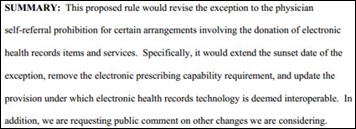












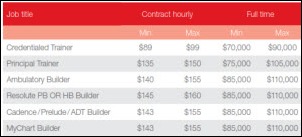




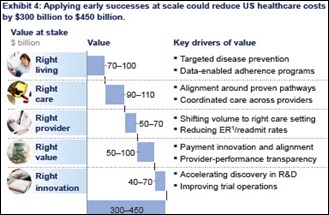
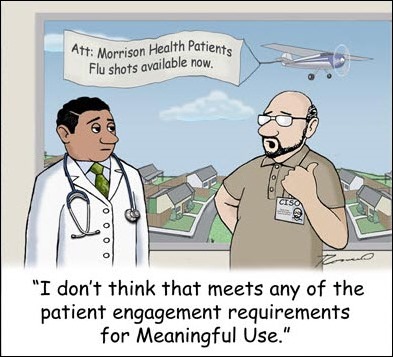

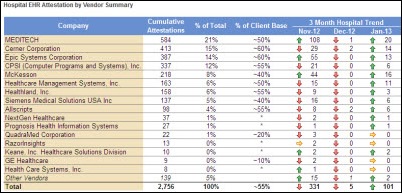


Regarding Epic interop – they have an astounding percent of their interop between Epic and non Epic.
Are you sure the problem is that your vendor doesn’t support the NwHIN or Direct Exchange standards?
Just silly. Get on board with the national standards and get over yourself!
A couple of reasons, very generalized, for why there are very few at-risk contracts:
– Most EHR vendors only want to sell software, and do not want to be responsible for longer term issues. The reality is that many of them have very few clinicians working for them and probably wouldn’t be great at figuring that out. As a good example, they don’t want to go at-risk for meeting MU because the providers handle the training and go-live.
– If they do offer at-risk contracts, these are stacked against the provider for two reasons. First, there’s a presumption that the software is flawless and, if used appropriately, will provide good outcomes, and so the metrics don’t really take that into account, and give the vendor an out if the provider implemented it “wrong”. Second, the vendor would only offer them if they thought they were going to get the money, and also not really be at risk if something bad happens. Like in construction, most problems that occur have both parties at fault to some extent, so it comes down to who can point fingers the best, and they have a lot more practice than you do.
– For many metrics, you need the “pre” data. Without an EMR, that data can be hard to come by, and maybe even impossible, so you can’t find metrics that really suffice.
– Most EMR implementations are done so quickly that there’s precious little time to build in metrics, and those that get built are usually financial. Nobody wants to spend the extra effort to build them.
– Vendors typically are unwilling to accept less if they fail, but happy to accept more if they succeed. Since their pricing is a mystery, they can easily game it by jacking up the price and then saying they’re “at-risk”, when in fact they lose nothing if they fail.
Anyway, just my thoughts based on my experience exploring this option with a few vendors, and always deciding that it wouldn’t work out well for the providers.
It seems to me that the at-risk scenarios are not apples to apples. I worked on the insurance side and what I saw most of was still risk transfer/capitation models -the money is flowing to the provider to manage and save or lose based on performance. A vendor putting fees at risk is different, then you’ll always end up with the battle over who’s fault it was and having to carve out pieces of risk (which you’d have to do because no vendor is going to go totally at risk) would be a giant pain as Mr. H has said. Plus, with healthcare reform, I don’t know why you’d possibly want to put fees at risk, margins are already tight for hospitals and sequester’s putting extra pressure on. How could you possibly guarantee a certain ROI…reimbursements might completely change and all the sudden increases you’d planned to get through your emr no longer exist.
Plus, that’s just how the software industry works, you license software and it’s difficult to shift from that mindset. It’s priced totally differently (per user, not per member).
Re: At-risk contracts. Health systems are often averse to managing the complexity of at-risk contracts. If they believe in the vendor’s ROI, they’d rather pay a fair price and move on.
Entry level jobs – Only speaking from the ambulatory side, but ANY position with a smaller organization that entails the support and/or implementation of EHRs is a great starting point. When you provide support, you talk with a variety of customers, from different environments, facing different challenges. It forces you to be accountable (if you’re a good customer service person, anyway) and get hands-on experience with the challenges of supporting PM and EHR systems. Unfortunately, most recent grads want to jump right in and start doing implementations and earning bigger paychecks. I believe that those who can troubleshoot problems and solve workflow problems creatively have much more longevity and value to employers and customers alike.
Re the helicopter crash: The guy ran out of gas. He was not texting within ten minutes of the crash. He was probably over tired. He made a stupid decision to fly with a low fuel supply. Texting is a huge distraction when performing any critical function, but it seems like it’s a stretch to implicate texting here, and an exaggeration to make it the story lead. It’s like saying having a conversation by voice phone “may have” contributed to a crash even if the conversation is not proximate to the event…
RE: “… the recordings could be used for training and for inclusion in the EHR to support less-detailed operative notes.” How would such a recording be shared with the patient’s primary care provider? A written operative note can be mailed, FAXed, or emailed, but a video would probably require direct access to the EMR.
Regarding at-risk contracts, Eclipsys did that about 10 years ago. With their tagline of “The Outcomes Company,” several such contracts were created. A team came in – gratis – during the sales process to evaluate where measureable improvements could be made – everything from cost-savings from using less paper to reductions in adverse medication events. A set of objectives and metrics was developed that could be specifically tied to use of the product (Sunrise Clinical Manager) and with three stages. If the outcomes weere below a certain amount, the client paid less. If the objectives were met, Eclipsys got paid the contract value. If stretch targets were met, Eclipsys got paid more because the client was also getting a bigger benefit. It was an arduous process, but one in which a true partnership based on incentives and shared success was formed.
About Big Data and McKinsey: “Our estimate of $300 billion to $450 billion in reduced health-care spending could be conservative…”
No disclosure as to who commissioned and paid for the report.
This paper reminds me of the RAND report commissioned and paid for by Cerner in GE that predicted $ billions in savings from HIT only to be shown to be erroneous. in a recent RAND report.
I remain interested in reading one report that these systems and data result in imprpved outcomes and reduced overall costs.
Show me the beef.
JM asked about education for those new to informatics. I conduct the Nursing Informatics Boot Camp at various locations around the country. This intensive two day course focuses on current informatics trends and issues in health. It includes content for nurses interested in attaining contact hours or becoming Certified Informatics Nurses. Other clinical professionals working in informatics may wish to take the course to become exposed to the course topics. Topics include:
√ Information Management and Knowledge Generation
√ Professional Practice
√ System Life Cycle
√ Information Technology
√ Current Issues
√ Case Studies
Re. Entry level jobs in HIT. Vendors are a good place to start. Epic and Cerner love recent grads. They seem less particular about actual experience working in healthcare. As an IT Manager at a hospital, I can tell you I will rarely consider hiring someone that does not have HIT experience or at least functional experience as a nurse, in a billing office, registration, etc. Experience matters a lot and a job with a vendor is a good way to get your foot in the door. The HIStalk sponsors offer an array of websites to scope out for jobs!
At risk contracts for EMRs?
The legal contract would have to be about 1,000 pages. As Mr. H points out the complexity of such a project, the number of variables that drive the outcome, the time horizon, staff turnover (both sides) and the likely changes in local/state federal regulation would make it the arrangement insane.
In my experience the only at risk contacts for IT or services (facility management) that work, and I use the term loosely, are very focused and sub-sets of a department’s operation, eg – rev cycle. And typically they are structured as FM arrangements where the vendor has significant control over the operating environment.
I would only consider an at risk EMR arrangement if I first had a full FM contract to run the institution…and even then hesitate depending upon the physician arrangements.
Re: Dr. Joe Bormel,
Qmed looses a good one. Now we really have to ask – What is the future for CPR/Affinity? Can’t believe the Fisco equity guys are going to make big investments in a struggling EMR when they already doubled their money on selling the coding systems.
Baffled by how the press proposes that the 1-yr noncompete is almost a beneficial thing for ex-Epic employees. Yeah right. Kind of like how being fired allows employees to rediscover themselves and explore new life opportunities!
It is similiar to the same nonsense I saw in this week’s Economist where they stated that the number of H1-b visas should either be doubled or even higher since the are more applicants than visas available. Nevermind that in the past 2 years there have been a ton of reports/investigations that have slammed the abuses of the current program by the companies that are granted the majority of the visas and the employees/positions they go to fill. It is basically an outsourcing program that allows large companies to bring in STEM workers (largely from India) at wages significantly below US market rates and often abuse them/violate US labor laws in the process. There are also a ton of jobs that are certainly in no way ‘hi tech’ or STEM-related are also granted H1-b visas. Hell, even the WSJ (certainly no leftist/unionist bastion) has heavily criticized the current program in the past year with a couple of articles/op-eds.